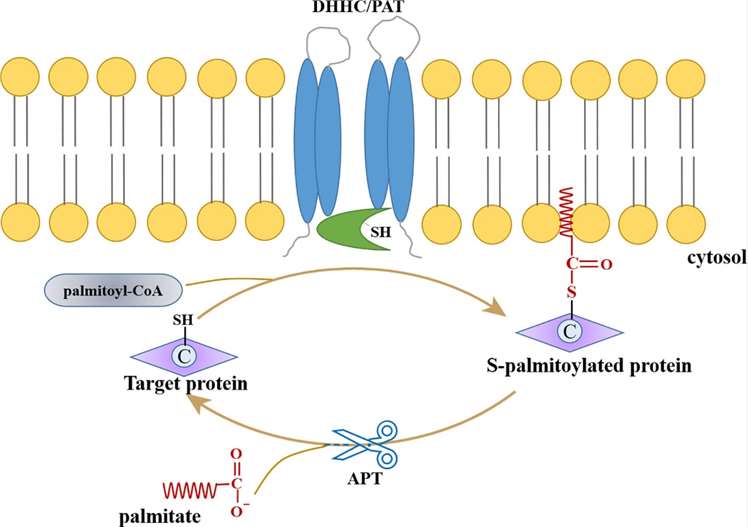Palmitoylation Analysis Service
Palmitoylation, a distinctive reversible lipid modification, wields control over protein association with cell membranes and transport across membranes. At Creative Proteomics, our expertise extends to high-quality palmitoylation analysis services. We specialize in the identification, quantification, and characterization of palmitoylation, ensuring valuable insights for your protein research initiatives.
What is Palmitoylation
Protein palmitoylation stands as a crucial post-translational modification, involving the addition of a palmitoyl group—derived from palmitic acid—to specific cysteine residues of proteins. This modification is dynamic and reversible, exerting profound effects on protein localization, stability, and function within the cell. Palmitoylation is orchestrated by palmitoyl acyltransferases (PATs) and has emerged as a pivotal regulator of diverse cellular processes.

Fig.1 Schematic of palmitoylation (Li, X. et al.; 2022)
Palmitoylation introduces a 16-carbon saturated fatty acid (palmitate) to the target protein, facilitating its association with cellular membranes. This reversible modification dynamically regulates the subcellular localization of proteins, impacting their trafficking and membrane interactions. The attachment of palmitate to cysteine residues is often termed S-palmitoylation, and it can occur alone or in combination with other lipid modifications, such as myristoylation or prenylation. The reversible nature of palmitoylation provides a nuanced mechanism for cellular control, allowing proteins to shuttle between membrane and non-membrane compartments in response to cellular signals.
Applications of Palmitoylation Analysis
- Cell Signaling Study
Protein palmitoylation is integral to diverse cellular functions, including neuronal signaling, immune response, and cellular trafficking. The modification plays a crucial role in the regulation of neurotransmitter receptors, ion channels, and G-proteins in the nervous system. - Disease Research
Dysregulation of palmitoylation is associated with various diseases, including neurological disorders and cancer. Consequently, understanding the principles of palmitoylation opens avenues for therapeutic interventions. - Drug Development
Targeting PAT enzymes or modulating palmitoylation dynamics presents opportunities for drug development, offering potential treatments for diseases where aberrant protein palmitoylation is implicated.
Our Service
Creative Proteomics has advanced protein detection technologies and can provide customized services to researchers and scientists to help them reveal the complexity of PTM using powerful mass spectrometry technologies. Our services are thoughtful and detailed and the process of palmitoylation analysis service is as follows:

Fig.2 Palmitoylation analysis workflow
- Sample Preparation
Proper extraction and preparation of proteins from biological samples to ensure preservation of palmitoylated proteins. - Palmitoylation Enrichment
Enrichment techniques are employed to isolate palmitoylated proteins or peptides. This step is crucial as palmitoylation modifications are often present in low abundance compared to unmodified proteins. - Detection
WB, protein microarrays and LC-MS/MS are powerful tools for the identification and quantification of palmitoylated peptides, and they provide detection information that facilitates a comprehensive analysis of palmitoylation. - Bioinformatics Analysis
Advanced bioinformatics tools are used to analyze data, identify palmitoylated peptides, and map these modifications to protein sequences. - Result Delivery
After professional data analysis, we deliver results quickly and consistently.
Creative Proteomics brings a wealth of experience to the field of protein research. Our comprehensive services and products cover the entire spectrum of utilizing suitable and efficient gateways. Utilizing our proprietary platform, we have successfully implemented many proteomics research projects. If you are interested, please contact us for more information and a quote.
Reference
- Li, X.; et al. Protein Palmitoylation Modification During Viral Infection and Detection Methods of Palmitoylated Proteins. Frontiers in Cellular and Infection Microbiology. 2022, 12: 821596

